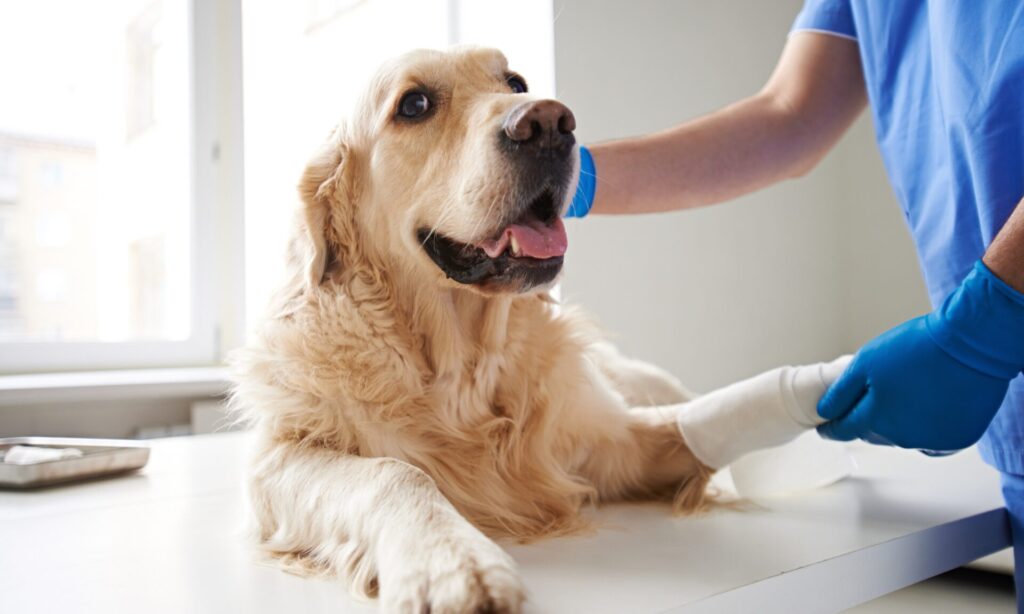
Introduction
Seeing your dog limp can be scary. You want to help but may not know what to do. This guide explains first aid for a limping dog in clear, simple steps.
Let’s explore how to treat a limping dog with love and smart care.
What Causes a Dog to Limp?
A limping dog may have many reasons for pain. Some causes are minor, while others need vet care. Common reasons include:
- Sprains or strains from running or jumping
- Cuts or wounds on the paw or leg
- Insect bites or stings
- Broken nails or cracked pads
- Arthritis or joint pain
- Hip or knee problems
- Fractures or dislocations
Watch your dog closely to spot the cause. Knowing the reason helps you give better first aid.
Spot the Signs of a Limping Dog
A limping dog may show signs like:
- Favoring one leg
- Refusing to walk or run
- Whining or licking the sore area
- Swelling or redness
- Holding a paw off the ground
- Stiff movement or slow walking
If your dog shows these signs, act calmly. Don’t panic. First aid helps ease pain and prevent more damage.
Stay Calm and Keep Your Dog Still
When your dog starts limping, stay calm. Speak in a soft voice and avoid sudden moves. Keep your dog still and quiet.
Don’t let them run or jump. Movement may make the injury worse. Use a leash if needed to control motion.
Comfort your dog with gentle touch. Your calm behavior helps them feel safe.

Check the Injured Leg or Paw
Gently check your dog’s leg or paw. Look for cuts, swelling, or foreign objects. Use a flashlight if needed.
Start with the paw pads and nails. Then move up the leg slowly. Watch for signs of pain or flinching.
If your dog growls or pulls away, stop. Don’t force the exam. You may need a vet to check safely.
Clean Minor Cuts or Scratches
If you find a small cut, clean it gently. Use warm water and mild soap. Pat dry with a clean towel.
Apply pet-safe antiseptic to prevent infection. Avoid human products like alcohol or hydrogen peroxide. These may sting or harm tissue.
Cover the wound with a clean bandage if needed. Change it daily and watch for signs of infection.
Remove Foreign Objects Carefully
Sometimes a limping dog steps on glass, thorns, or sharp rocks. If you see something stuck, remove it gently.
Use tweezers to pull out small objects. Clean the area with warm water and antiseptic. Watch for bleeding or swelling.
If the object is deep or hard to remove, call your vet. Don’t dig or poke too much.
Apply Cold Compress for Swelling
If your dog’s leg is swollen, use a cold compress. Wrap ice in a towel and apply for ten minutes.
Do this two to three times a day. Cold helps reduce swelling and pain. Never place ice directly on skin.
Keep your dog calm during treatment. Offer treats or soft praise to help them relax.
Support the Injured Leg
If your dog struggles to walk, support the injured leg. Use a towel under the belly to help lift and guide them.
Avoid long walks or stairs. Carry small dogs if needed. Let large dogs rest in a quiet space.
Don’t use splints or wraps unless your vet advises. Improper support may cause more harm.
Limit Activity and Movement
Rest is key for a limping dog. Limit activity for a few days. No running, jumping, or rough play.
Use a crate or small room to keep your dog calm. Offer toys that don’t require movement.
Short leash walks for bathroom breaks are okay. Keep walks slow and short.
Watch for Signs of Serious Injury
Some limping dogs need vet care right away. Call your vet if you see:
- Severe swelling or bruising
- Bleeding that won’t stop
- Bone sticking out
- Refusal to move or eat
- Limping that lasts more than 48 hours
Don’t wait if your dog seems in pain. Early care prevents bigger problems.
Don’t Give Human Medicine
Never give your dog human pain medicine. Drugs like ibuprofen or aspirin can be toxic. Only use vet-approved medications.
Call your vet for safe options. They may prescribe anti-inflammatory drugs or pain relief. Follow dosage instructions closely.
Store medicine away from pets and kids.
Use a Soft Bed for Rest
A limping dog needs a soft place to rest. Use a padded bed or blanket in a quiet spot. Avoid hard floors or cold areas.
Keep food and water nearby. Help your dog move slowly and safely. Rest helps the body heal faster.
Keep Your Dog’s Weight Healthy
Extra weight adds stress to joints and bones. Feed your dog a balanced diet. Avoid table scraps and high-fat treats.
Ask your vet about weight goals. Use portion control and regular feeding times. Healthy weight supports recovery and prevents future limping.
Prevent Future Injuries
Once your dog heals, take steps to prevent future limping. Use ramps for stairs or cars. Avoid rough play on hard surfaces.
Trim nails regularly to prevent breaks. Check paws after walks for cuts or debris. Keep your dog active but safe.
Regular vet checkups help catch joint issues early.
Help Senior Dogs with Joint Pain
Older dogs may limp from arthritis or joint problems. Offer joint supplements like glucosamine or omega-3 oils. Ask your vet for advice.
Use orthopedic beds and non-slip mats. Keep walks short and gentle. Warm compresses may help sore joints.
Senior dogs need extra love and care. Stay patient and supportive.
Know When to Resume Activity
After rest and recovery, slowly return to normal activity. Start with short walks and light play. Watch for signs of pain or limping.
Increase activity over days, not hours. Let your dog set the pace. If limping returns, stop and rest again.
Your vet can guide you on safe recovery steps.
Emotional Support for Your Dog
A limping dog may feel scared or stressed. Offer comfort with calm words and gentle touch. Stay close and keep routines steady.
Avoid loud noises or sudden changes. Your dog feels safer with your support. Love and care help healing too.
Conclusion
First aid for a limping dog starts with calm care and smart steps. From checking the injury to limiting movement, every action helps.
Use cold compresses, clean wounds, and offer rest. Watch for serious signs and call your vet when needed. Never give human medicine.
Reference: Read More

